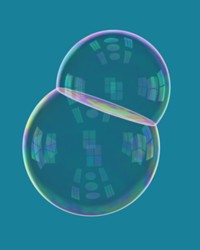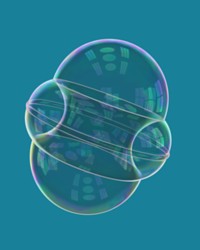Double bubble is no trouble

A standard double bubble
Four mathematicians have finally confirmed that the familiar double soap bubble is indeed the best way to enclose two separate volumes of air.
In a double bubble, the joining surface bulges a little into the larger of the two bubbles. The three surfaces meet along a circle at 120o.
If the two bubbles enclose the same volume, the separating surface is flat.
A common theme of many problems in mathematics is that of efficiency. For example,
- What is the shortest way from A to B?
- How can a task be carried out as quickly as possible?
- How small can a surface be while still enclosing and separating some number of given volumes?
A solution to the last of these problems is known as a minimal surface. The minimal surface enclosing a single volume is a sphere, as was asserted by Archimedes and proved by Schwarz in 1884. But progress on the two-volume problem - "How small can a surface be while enclosing and separating two given volumes?" - has been slower.
Some facts about any minimal surface enclosing and separating two volumes have been known for some time, however. For example, the surface would have to be rotationally symmetric about a line, and consist of surfaces meeting in threes at 120o angles along curves.
The trouble was that, although the familiar double bubble configuration certainly satisfied all the known conditions, so did some other, considerably stranger, configurations. These configurations are never seen in nature, and can only be seen using computer modelling. Below is one such "non-standard" bubble. Here the larger region is broken into two components, one a tiny ring, like a torus, around the other region, which is also torus-like.

A nonstandard double bubble
Although noone had managed to find a minimal surface among these strange configurations, or "non-standard bubbles", mathematicians need more than this to conclude that none exists. In order to be sure that the genuine and only minimal surface was the familiar double bubble, the existence of a nonstandard minimizer had to be definitively ruled out - and that is what a team of four mathematicians did earlier this year.
Frank Morgan of Williams College, Massachusetts, Michael Hutchings of Stanford, and Manuel Ritori and Antonio Ros of Granada proved their result using only pencil and paper, despite the fact that the earlier proof (in 1995) of the special case when both volumes are the same was computer-aided, and very long. Their proof rests on arguments about rotations and stability.
In a fascinating postscript, a group of four undergraduates doing research last summer under Morgan's direction managed to extend the double bubble result to four dimensions, and, with some extra conditions, to five and higher dimensions as well.
Images courtesy of John M. Sullivan, Department of Mathematics, University of Illinois at Urbana-Champaign